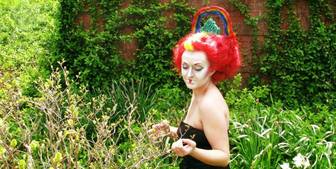|
I have recently been brushing up on my quick sketching skills and body composition sketches. This can be hard without a live model or one of those fun little wooden joint men. Thankfully while at undergrad I was introduced to a lovely website that is my own personal traveling model. posemaniacs.comThis lovely site allows the drawer to do timed sketches 10 seconds - 90 seconds of computer generated models. What I love about this site is the muscle structure of the model is exposed so if you are like me and like to know what is attached to what while drawing, you can see every bit of tissue and bone. Some poses are not as beneficial to a costumer than others, but the ability to quickly get the general shape of a model down on paper is a valuable skill. I do not use these poses for designs, but as I said, practice will make perfect. And, I never know, I MAY design a character that lies down all the time, so the lounging models will come in handy. Whether you use posemaniacs.com or some other site, a weekly or daily sketch session of poses will allow for a better undertanding of the body and through that the cloth and other materials we design to top it.
0 Comments
A colleague of mine recently commented on how she believed theatre makeup was becoming obsolete and that more "street" or everyday makeup brands were being used in the place of classic theatre brands such as Ben Nye and Krylon. This piqued my interest. I did some research including getting ahold of a makeup artist and wig designer friend of mine Melissa Thiede.  Photo courtesy of Melissa Thiede Photo courtesy of Melissa Thiede I had noticed a large array of makeup at different theatres I have worked at. Most still used traditional oil based or water based stage paints, but recently I had noticed such companies as MAC and Cover Girl sneaking into different artists' makeup bags. Was this becoming a trend? I asked Melissa for a professional's opinion. Bakewell: "Have you noticed a transition in theatre makeup away from "stage" makeups towards "street" makeups like MAC? If so why do you think that is?" Thiede: " I have heard that there has been changes that have occurred industry. I've only been doing makeup for about four years. I haven't seen any major transitions. Lots of new techniques. This always makes my job exciting. From what I heard from other artists, characters' makeup looks have become more blended and less bold shapes. The makeup can more easily translate from stage to close up." Bakewell: "Could you give me an example of one of the techniques that has changed since you've started makeup?" Thiede: "One technique that has really changed is blocking out your eyebrows. I was first taught to use nose and scar wax. Even then, my teacher said it wasn't something used much anymore. It can fall apart very easily when an actor moves their brows. Now, I don't really know any artist that uses it. I was taught by another teacher to use soap or a glue stick to block out eyebrows. This technique appears more natural on an actor's face. Their eyebrow hair easily stays up and out of the way." Bakewell: "What is the difference between stage and street makeups in application?" Thiede: "Corrective stage makeup and everyday makeup is similar. You have to highlight and contour just in different ways. My favorite type of makeup to apply is big transformations. For example, an actor into a monster or creature of some sort. " So based on the questions I've asked Melissa and some industry research, it looks as if there may be a slight transition to more everyday brands of makeup. The old severe contouring and highlighting of the Vaudeville days may be on it's way out. This is understandable since many theatres are become more intimate and actors sometimes physically interact with their audiences. Many performances are also being taped, broadcasted, or shown in movie theatres. Stage makeup is not easily photographed since it is meant to be seen from a distance; not up close. I don't think I'll throw away my current stage makeup kit and run out to buy all new "street" palettes, eyeliners, and shadows, but it is nice to know I have that option.
|
Topics
All
Archives
July 2021
|
